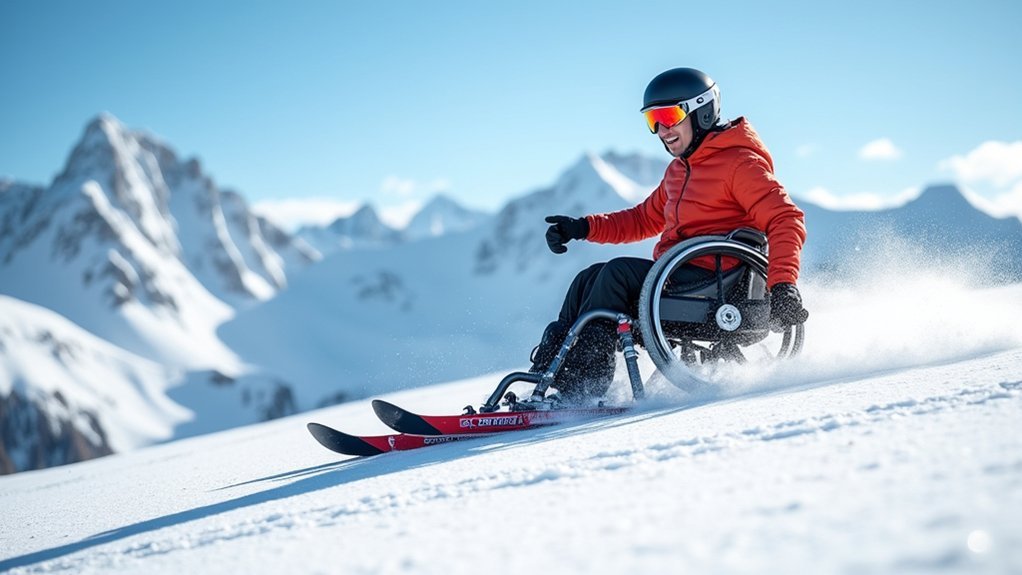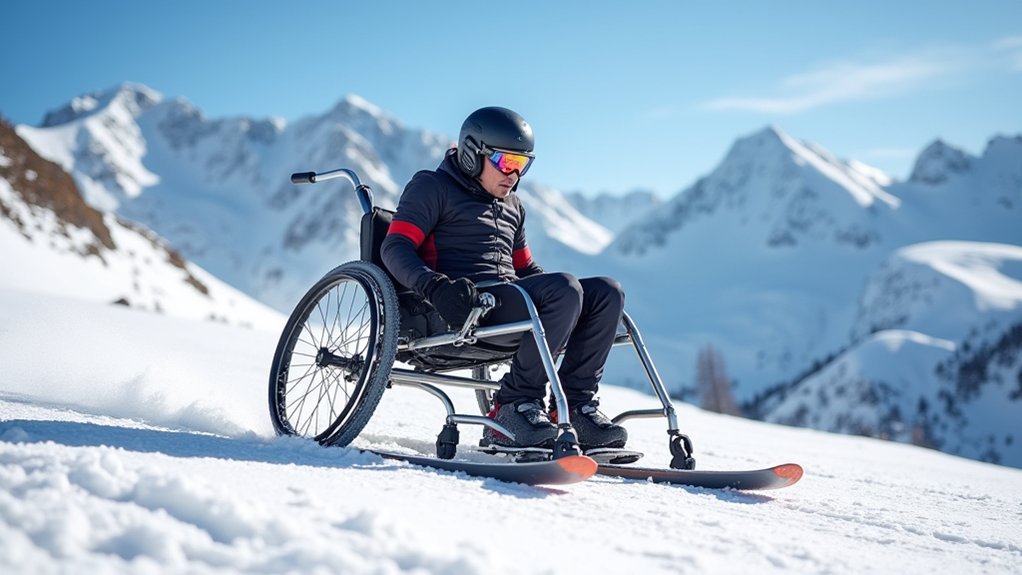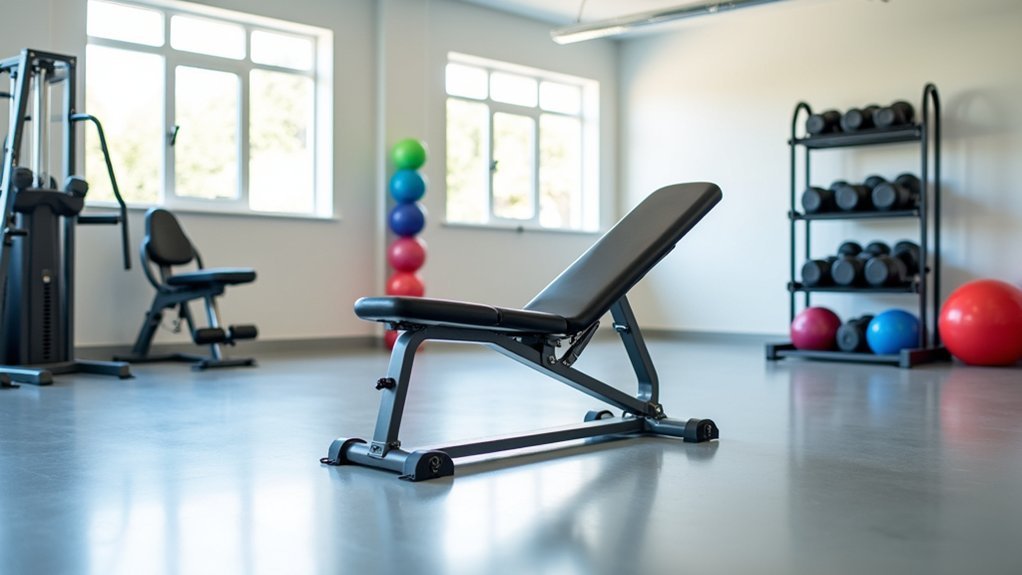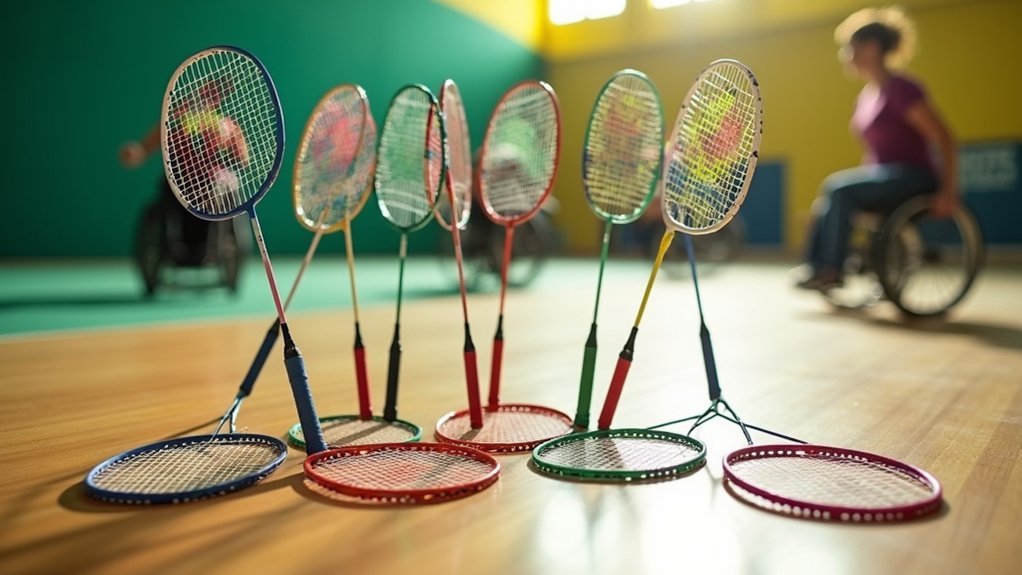Outriggers provide essential balance and control for wheelchair athletes in adaptive skiing. You’ll find options ranging from beginner-friendly Training Outriggers ($299) to professional-grade Custom Titanium models ($598). The right choice depends on your skill level and terrain preferences. Regular maintenance extends equipment life while proper techniques enhance your experience on powder, moguls, and hard-packed snow. Joining structured training programs helps you master skills gradually—your path to independence on the slopes awaits.
The Evolution of Outrigger Technology for Adaptive Skiing

While traditional skiing relies on poles for balance and control, adaptive skiing has revolutionized this concept through outriggers—specialized equipment that has transformed the sport for wheelchair athletes.
Since their inception, outriggers have evolved dramatically, becoming essential tools that provide enhanced stability and control for those who typically use wheelchairs.
Today’s designs focus on user-friendly setups that make balancing, stopping, and turning more intuitive.
Enabling Technologies, pioneering adaptive equipment since 1984, continues to innovate with options like the Superlite Outriggers—favorites among Paralympians for their versatility across skill levels.
The introduction of custom titanium outriggers has further improved the strength-to-weight ratio, offering wheelchair athletes greater maneuverability and comfort while traversing the slopes.
Selecting the Right Outriggers for Your Skiing Style
The technological advancements in outriggers have created multiple options for wheelchair athletes hitting the slopes. Your skiing ability and personal preferences should guide your outrigger selection for maximum performance and enjoyment.
Today’s outrigger technology offers wheelchair athletes customizable options that match their unique skiing style and performance goals.
If you ski independently, Stand Up Outriggers offer excellent balance control, while Bi Ski Outriggers complement a bi-ski setup perfectly.
For beginners or those building confidence, Training Outriggers starting at $299.00 provide additional support and stability as you develop your skills.
Competitive athletes and Paralympians often prefer Custom Titanium Outriggers at $598.00 for their superior durability and performance advantages. These premium outriggers excel in challenging conditions and high-intensity adaptive skiing.
Superlite Outriggers remain a popular choice across experience levels, offering versatile setup options that enhance your turning, stopping, and balance capabilities on any terrain.
Titanium vs. Aluminum: Material Benefits for Wheelchair Athletes

When choosing outriggers for adaptive skiing, material selection greatly impacts your performance on the slopes.
Titanium outriggers offer significant advantages—they’re lighter, more durable, and provide enhanced movement freedom while skiing. You’ll notice titanium absorbs vibrations better, resulting in smoother rides across varied terrain.
Though titanium comes with a higher price tag, its superior corrosion resistance guarantees a longer lifespan, making it cost-effective in the long run. The exceptional strength-to-weight ratio also allows for more innovative designs that improve functionality and versatility.
Don’t dismiss aluminum options, however.
They’re budget-friendly while still providing reliable support. If you’re conscious about initial investment, aluminum outriggers remain a popular choice that delivers dependable performance without breaking the bank.
Mastering Balance and Control With Outriggers on Various Terrains
You’ll find that mastering outriggers transforms your experience on various terrains, from the soft give of powder snow to the challenging bumps of mogul fields.
When maneuvering through powder, you’ll need to keep your outriggers slightly wider and maintain a consistent pressure to prevent sinking.
Your stability skills on hard-pack surfaces and through mogul traversal will develop as you learn to shift your weight dynamically while using your outriggers as precision balance points.
Powder Navigation Techniques
Mastering powder snow conditions requires specialized techniques that wheelchair athletes can develop through proper outrigger usage. When maneuvering through powder, your outriggers become essential tools for maintaining stability while adapting to the unpredictable nature of soft snow.
- Use the two-point hold technique with your outriggers to effectively steer and turn through powder.
- Practice gradually increasing your turning angles to improve speed control.
- Integrate flip ski outriggers for enhanced lateral control in deeper snow.
- Prevent ski tips from crossing by maintaining proper outrigger positioning.
- Build confidence in different snow conditions before shifting from outriggers to traditional poles.
With consistent practice, you’ll develop the muscle memory needed to navigate powder confidently, allowing you to experience the unique freedom that comes with mastering challenging snow conditions.
Mogul Field Traversal
Steering through mogul fields presents unique challenges for wheelchair athletes, though outriggers serve as your essential tools for maintaining balance and control across these bumpy terrains.
When maneuvering moguls, you’ll need to adjust your outriggers strategically to distribute weight effectively over each bump. Position your outriggers slightly wider than normal to create a stable foundation.
As you approach each mogul, flex your core and shift your body weight slightly forward, using the outriggers to guide your turns and control your speed. This technique prevents unwanted acceleration and helps maintain an upright posture.
Regular practice on mogul fields will strengthen your core muscles and improve your outrigger coordination.
Hard-Pack Stability Skills
Hard-packed snow conditions differ greatly from mogul fields, requiring a distinct approach to outrigger positioning and body mechanics.
When you’re maneuvering these firmer surfaces, your outriggers become essential tools for maintaining stability while building independence and confidence.
- Position your outriggers slightly wider than shoulder-width to create a stable base
- Shift your weight subtly between outriggers to initiate turns without losing balance
- Practice small weight transfers to develop vital core strength and muscle memory
- Keep your upper body relaxed but engaged to respond quickly to terrain changes
- Experiment with outrigger placement—closer for speed control, wider for stability
As you master these techniques, you’ll find yourself moving with greater freedom and control across hard-packed terrain, turning potential challenges into opportunities for skill development and enjoyment.
Training Programs and Techniques for New Outrigger Users
When beginning your journey with wheelchair outriggers, a structured training program makes all the difference between frustration and success. In adaptive sports, mastering proper balance techniques first allows you to use outriggers effectively for turning and stopping, enhancing your overall skiing experience.
Start with gradual progression, practicing turns in both directions while using outriggers for stability. You’ll find the two-point hold technique particularly helpful for steering and maintaining control on the slopes.
Your instructor might incorporate tethers to guide your movements as you build confidence. These reins help control your speed and direction during early learning phases.
As you improve, you’ll shift from relying on sliders for support to using outriggers independently. Remember, techniques can be creatively adapted to your individual capabilities.
Paralympic Champions and Their Outrigger Setups

Paralympic champions have revolutionized how we view and implement outriggers in competitive skiing.
You’ll notice elite athletes often select Custom Titanium Outriggers starting at $598.00, prizing their lightweight durability and enhanced agility on challenging courses.
- Many champions rely on Superlite Outriggers for superior balance and turning capabilities.
- Athletes customize their setups between Stand Up or Mono Ski Outriggers based on individual skiing styles.
- Enabling Technologies’ 35+ years of innovation drives continuous improvements in adaptive equipment.
- The versatility of modern outriggers supports both Paralympic veterans and newcomers.
- Elite competitors depend on specialized outriggers to gain competitive advantages in high-stakes events.
With the right outrigger configuration, you’re following in the tracks of champions who’ve pushed the boundaries of adaptive skiing through strategic equipment selection.
Transitioning From Bi-Ski to Mono-Ski With Outrigger Support
When shifting from a bi-ski to a mono-ski, you’ll need to focus on building upper body strength through targeted resistance training to handle the demands of managing outriggers effectively.
You can improve your balance through techniques like seated core exercises and practice sessions that gradually reduce instructor support as your confidence grows.
Selecting the right outrigger equipment—considering length, grip comfort, and weight distribution—will greatly impact your control and ultimately enhance your independent skiing experience.
Building Upper Body Strength
As athletes shift from bi-skiing to mono-skiing, developing upper body strength becomes vital for success on the slopes. Your outriggers serve as key tools in this change, helping you build the muscle control needed for independent skiing.
- Focus on arm strength exercises that mimic the pushing and pulling motions used with outriggers.
- Strengthen your core muscles to improve trunk stability while maneuvering.
- Practice balance exercises that enhance your ability to make quick adjustments.
- Incorporate resistance training to build endurance in your shoulders and back.
- Use outriggers during practice sessions to develop muscle memory.
The more you work with your outriggers, the faster you’ll develop the necessary strength for confident mono-skiing.
This gradual progression will transform your skiing experience, giving you greater freedom and independence on the mountain.
Balance Training Techniques
The change from bi-skiing to mono-skiing represents a fundamental shift in how you’ll maintain stability on the slopes. Your outriggers become essential tools, compensating for the reduced base of support with just one ski beneath you. Daily practice with these handheld supports strengthens your core and improves trunk balance—crucial skills for mono-skiing success.
| Training Phase | Physical Benefit | Emotional Reward |
|---|---|---|
| Initial Balance | Core Stability | First Independence |
| Turn Practice | Trunk Control | Growing Confidence |
| Speed Management | Upper Body Strength | Exhilarating Freedom |
| Independent Skiing | Full Body Coordination | Transformative Pride |
As you progress, you’ll learn to initiate turns and control speed using your outriggers with decreasing dependence. This gradual shift builds both technical proficiency and self-assurance, ultimately leading to more independent skiing experiences on your mono-ski.
Equipment Selection Tips
Selecting the right outriggers stands as your most critical decision when shifting from bi-ski to mono-ski. As you change, you’ll need proper equipment that supports your developing balance and core strength while ensuring safety on varying terrain.
- Stand Up Outriggers offer excellent initial stability for beginners making the change.
- Custom Titanium Outriggers provide durability with reduced weight for advanced control.
- Adjustable outriggers allow you to modify height as your skills progress.
- Choose outriggers with comfortable grips for extended use during practice sessions.
- Consider snow conditions when selecting outrigger tips – wider for powder, narrower for packed surfaces.
Remember to practice the two-point hold technique with your outriggers on flat terrain before advancing to steeper slopes.
You’ll gradually reduce your dependency on support as your mono-ski confidence grows through consistent practice.
Equipment Maintenance: Extending the Life of Your Outriggers
Regular maintenance of your outriggers greatly impacts both their performance and longevity. After each skiing session, take time to clean your outriggers thoroughly, removing snow and moisture that could lead to corrosion.
Inspect them for signs of wear such as frayed straps or damaged components that might compromise your safety on the slopes.
Store your outriggers in a cool, dry environment when not in use to prevent damage from temperature fluctuations or humidity.
Don’t forget to periodically check and tighten all screws and bolts, as the vibrations during skiing can gradually loosen these connections.
For specific maintenance procedures and warranty details, consult your product manual—it’s your best resource for keeping your outriggers in prime condition year after year.
Customization Options for Enhanced Performance and Comfort
While proper maintenance guarantees your outriggers last longer, personalizing them to your specific needs can transform your skiing experience entirely.
Enabling Technologies offers extensive customization options across their entire outrigger line to match your unique requirements and skiing style.
Find the perfect configuration for your skiing journey with personalized outrigger options that elevate both performance and confidence.
- Superlite Outriggers feature versatile setups that adapt to your individual needs
- Custom Titanium Outriggers ($598.00+) deliver lightweight strength with personalized performance features
- Stand Up Outriggers ($399.00+) can be height and grip-adjusted for peak balance
- Training outriggers ($299.00+) include customization options perfect for beginners building confidence
- All customization options focus on enhancing both performance and comfort on the slopes
You’ll discover that properly customized equipment doesn’t just improve your technique—it transforms your entire relationship with the sport, allowing you to push boundaries you never thought possible.
Joining the Community: Adaptive Skiing Programs and Resources
Once you’ve mastered your personalized outriggers, connecting with the adaptive skiing community opens a world of support, friendship, and growth opportunities. Programs nationwide provide access to specialized equipment like Superlite Outriggers—the same gear trusted by Paralympians.
| Resource | What You’ll Find |
|---|---|
| Enabling Technologies | Professional outriggers since 1984; global expertise |
| OAS Fleet | Training outriggers starting at $299; varied equipment |
| Bi-Ski Programs | Seated skiing options for wheelchair users |
| Mono-Ski Lessons | Independent skiing techniques with instructor support |
These adaptive programs offer more than just equipment access—they’re gateways to community engagement. You’ll meet fellow athletes who understand your journey while developing skills in supportive environments. The adaptive skiing community welcomes everyone, regardless of experience level.
Frequently Asked Questions
Can You Ski if You Are in a Wheelchair?
Yes, you can ski from your wheelchair using adaptive equipment like the Bi-Ski, which has a bucket seat mounted on two skis. You’ll use outriggers for balance and can ski independently or with assistance.
Can a Disabled Person Ski?
Yes, you can absolutely ski if you’re disabled. Using adaptive equipment like mono-skis, bi-skis, and outriggers, you’ll find specially designed programs and instructors ready to help you enjoy the slopes safely.
How Do Paraplegics Ski?
You’ll ski using a mono-ski or bi-ski with a bucket seat mounted on skis. You’ll control your movements with handheld outriggers, using your upper body strength and core stability to turn and stop.
What Is Disabled Skiing Called?
You’ll often hear disabled skiing referred to as “adaptive skiing.” This term encompasses specialized equipment and techniques that allow you to enjoy skiing regardless of your disability, promoting independence on the slopes.
In Summary
You’ve now discovered the freedom outriggers can bring to your alpine adventures. Whether you’re riding a mono-ski or bi-ski, these essential tools transform what’s possible on the mountain. Choose the right materials, master proper technique, and connect with the adaptive skiing community. With regular maintenance and customization, your outriggers will support you for years to come. The slopes are waiting – it’s time to experience them your way.




Leave a Reply